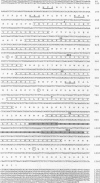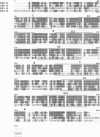Abstract
PCR was used to isolate nucleotide sequences that may encode novel members of the neuropeptide Y receptor family. By use of a PCR product as a hybridization probe, a full-length human cDNA was isolated that encodes a 375-aa protein with a predicted membrane topology identifying it as a member of the G-protein-coupled receptor superfamily. After stable transfection of the cDNA into human embryonic kidney 293 cells, the receptor exhibited high affinity (Kd = 2.8 nM) for 125I-labeled human pancreatic polypeptide (PP). Competition binding studies in whole cells indicated the following rank order of potency: human PP = bovine PP > or = human [Pro34]peptide YY > rat PP > human peptide YY = human neuropeptide Y. Northern blot analysis revealed that human PP receptor mRNA is most abundantly expressed in skeletal muscle and, to a lesser extent, in lung and brain tissue. A rat cDNA clone encoding a high-affinity PP receptor that is 74% identical to the human PP receptor at the amino acid level was also isolated. These receptor clones will be useful in elucidating the functional role of PP and designing selective PP receptor agonists and antagonists.
Full text
PDF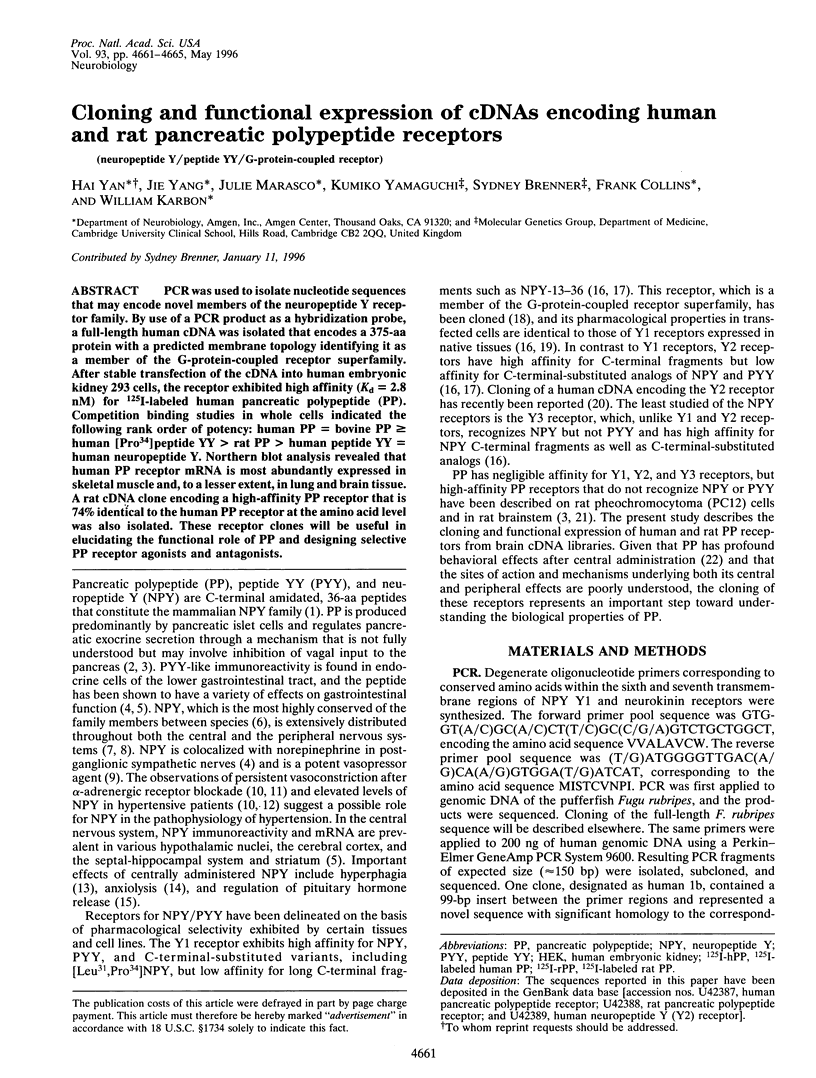
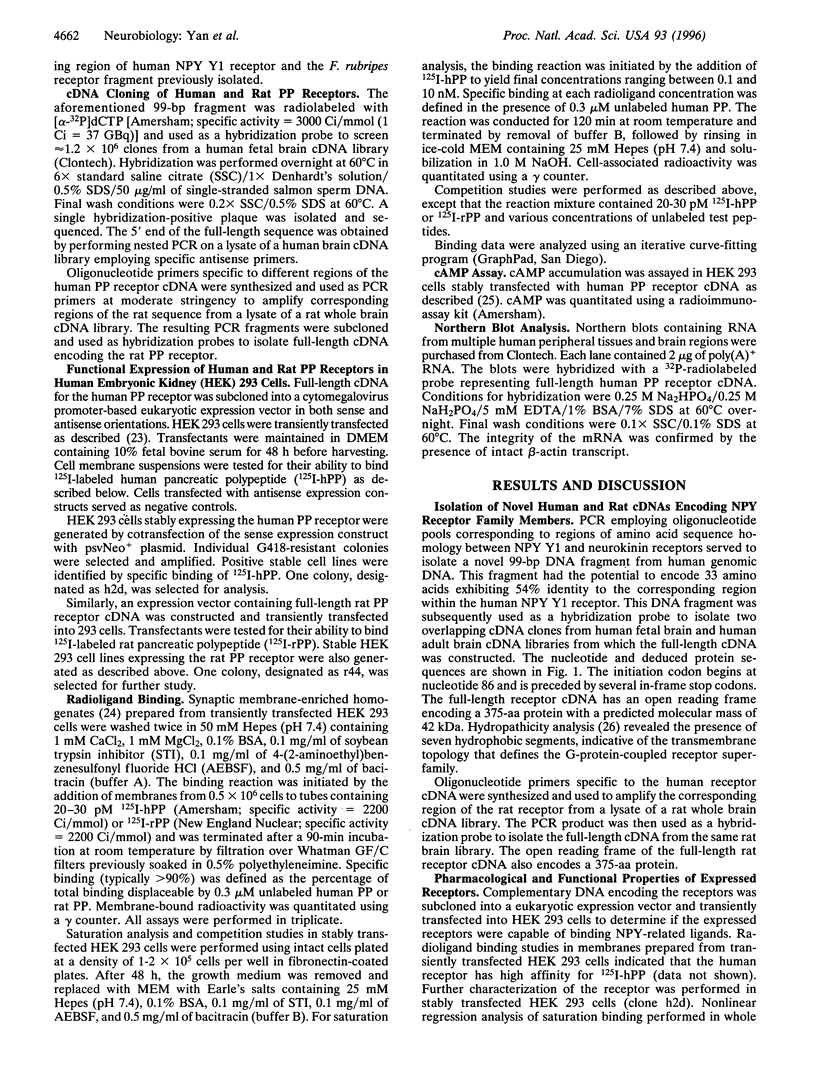
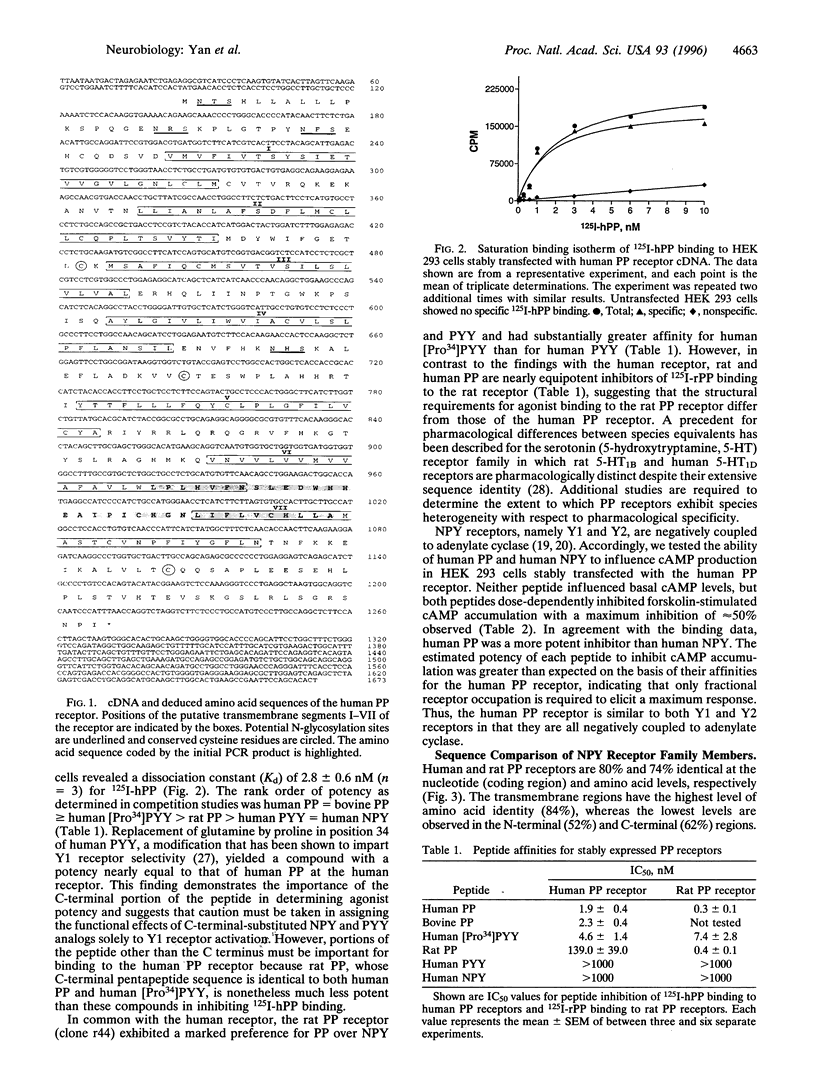


Images in this article
Selected References
These references are in PubMed. This may not be the complete list of references from this article.
- Bard J. A., Walker M. W., Branchek T. A., Weinshank R. L. Cloning and functional expression of a human Y4 subtype receptor for pancreatic polypeptide, neuropeptide Y, and peptide YY. J Biol Chem. 1995 Nov 10;270(45):26762–26765. doi: 10.1074/jbc.270.45.26762. [DOI] [PubMed] [Google Scholar]
- DiMaggio D. A., Chronwall B. M., Buchanan K., O'Donohue T. L. Pancreatic polypeptide immunoreactivity in rat brain is actually neuropeptide Y. Neuroscience. 1985 Aug;15(4):1149–1157. doi: 10.1016/0306-4522(85)90259-3. [DOI] [PubMed] [Google Scholar]
- Dixon R. A., Sigal I. S., Candelore M. R., Register R. B., Scattergood W., Rands E., Strader C. D. Structural features required for ligand binding to the beta-adrenergic receptor. EMBO J. 1987 Nov;6(11):3269–3275. doi: 10.1002/j.1460-2075.1987.tb02645.x. [DOI] [PMC free article] [PubMed] [Google Scholar]
- Dumont Y., Fournier A., St-Pierre S., Quirion R. Characterization of neuropeptide Y binding sites in rat brain membrane preparations using [125I][Leu31,Pro34]peptide YY and [125I]peptide YY3-36 as selective Y1 and Y2 radioligands. J Pharmacol Exp Ther. 1995 Feb;272(2):673–680. [PubMed] [Google Scholar]
- Dumont Y., Martel J. C., Fournier A., St-Pierre S., Quirion R. Neuropeptide Y and neuropeptide Y receptor subtypes in brain and peripheral tissues. Prog Neurobiol. 1992;38(2):125–167. doi: 10.1016/0301-0082(92)90038-g. [DOI] [PubMed] [Google Scholar]
- Edvinsson L., Ekman R., Thulin T. Increased plasma levels of neuropeptide Y-like immunoreactivity and catecholamines in severe hypertension remain after treatment to normotension in man. Regul Pept. 1991 Feb 26;32(3):279–287. doi: 10.1016/0167-0115(91)90021-8. [DOI] [PubMed] [Google Scholar]
- Eva C., Keinänen K., Monyer H., Seeburg P., Sprengel R. Molecular cloning of a novel G protein-coupled receptor that may belong to the neuropeptide receptor family. FEBS Lett. 1990 Oct 1;271(1-2):81–84. doi: 10.1016/0014-5793(90)80377-u. [DOI] [PubMed] [Google Scholar]
- GRAY E. G., WHITTAKER V. P. The isolation of nerve endings from brain: an electron-microscopic study of cell fragments derived by homogenization and centrifugation. J Anat. 1962 Jan;96:79–88. [PMC free article] [PubMed] [Google Scholar]
- Grundemar L., Håkanson R. Multiple neuropeptide Y receptors are involved in cardiovascular regulation. Peripheral and central mechanisms. Gen Pharmacol. 1993 Jul;24(4):785–796. doi: 10.1016/0306-3623(93)90151-m. [DOI] [PubMed] [Google Scholar]
- Heilig M., Söderpalm B., Engel J. A., Widerlöv E. Centrally administered neuropeptide Y (NPY) produces anxiolytic-like effects in animal anxiety models. Psychopharmacology (Berl) 1989;98(4):524–529. doi: 10.1007/BF00441953. [DOI] [PubMed] [Google Scholar]
- Herzog H., Hort Y. J., Ball H. J., Hayes G., Shine J., Selbie L. A. Cloned human neuropeptide Y receptor couples to two different second messenger systems. Proc Natl Acad Sci U S A. 1992 Jul 1;89(13):5794–5798. doi: 10.1073/pnas.89.13.5794. [DOI] [PMC free article] [PubMed] [Google Scholar]
- Krause J., Eva C., Seeburg P. H., Sprengel R. Neuropeptide Y1 subtype pharmacology of a recombinantly expressed neuropeptide receptor. Mol Pharmacol. 1992 May;41(5):817–821. [PubMed] [Google Scholar]
- Kyte J., Doolittle R. F. A simple method for displaying the hydropathic character of a protein. J Mol Biol. 1982 May 5;157(1):105–132. doi: 10.1016/0022-2836(82)90515-0. [DOI] [PubMed] [Google Scholar]
- Larhammar D., Blomqvist A. G., Yee F., Jazin E., Yoo H., Wahlested C. Cloning and functional expression of a human neuropeptide Y/peptide YY receptor of the Y1 type. J Biol Chem. 1992 Jun 5;267(16):10935–10938. [PubMed] [Google Scholar]
- Lundberg J. M., Tatemoto K. Pancreatic polypeptide family (APP, BPP, NPY and PYY) in relation to sympathetic vasoconstriction resistant to alpha-adrenoceptor blockade. Acta Physiol Scand. 1982 Dec;116(4):393–402. doi: 10.1111/j.1748-1716.1982.tb07157.x. [DOI] [PubMed] [Google Scholar]
- Martin G. R., Humphrey P. P. Receptors for 5-hydroxytryptamine: current perspectives on classification and nomenclature. Neuropharmacology. 1994 Mar-Apr;33(3-4):261–273. doi: 10.1016/0028-3908(94)90058-2. [DOI] [PubMed] [Google Scholar]
- Miyazaki K., Funakoshi A. Distribution of pancreatic polypeptide-like immunoreactivity in rat tissues. Regul Pept. 1988 May;21(1-2):37–43. doi: 10.1016/0167-0115(88)90089-4. [DOI] [PubMed] [Google Scholar]
- Nakajima M., Inui A., Teranishi A., Miura M., Hirosue Y., Okita M., Himori N., Baba S., Kasuga M. Effects of pancreatic polypeptide family peptides on feeding and learning behavior in mice. J Pharmacol Exp Ther. 1994 Feb;268(2):1010–1014. [PubMed] [Google Scholar]
- O'Dowd B. F., Hnatowich M., Caron M. G., Lefkowitz R. J., Bouvier M. Palmitoylation of the human beta 2-adrenergic receptor. Mutation of Cys341 in the carboxyl tail leads to an uncoupled nonpalmitoylated form of the receptor. J Biol Chem. 1989 May 5;264(13):7564–7569. [PubMed] [Google Scholar]
- Potter E. K., Fuhlendorff J., Schwartz T. W. [Pro34]neuropeptide Y selectively identifies postjunctional-mediated actions of neuropeptide Y in vivo in rats and dogs. Eur J Pharmacol. 1991 Jan 25;193(1):15–19. doi: 10.1016/0014-2999(91)90194-u. [DOI] [PubMed] [Google Scholar]
- Rose P. M., Fernandes P., Lynch J. S., Frazier S. T., Fisher S. M., Kodukula K., Kienzle B., Seethala R. Cloning and functional expression of a cDNA encoding a human type 2 neuropeptide Y receptor. J Biol Chem. 1995 Sep 29;270(39):22661–22664. doi: 10.1074/jbc.270.39.22661. [DOI] [PubMed] [Google Scholar]
- Schwartz T. W., Sheikh S. P., O'Hare M. M. Receptors on phaeochromocytoma cells for two members of the PP-fold family--NPY and PP. FEBS Lett. 1987 Dec 10;225(1-2):209–214. doi: 10.1016/0014-5793(87)81159-6. [DOI] [PubMed] [Google Scholar]
- Stanley B. G., Leibowitz S. F. Neuropeptide Y injected in the paraventricular hypothalamus: a powerful stimulant of feeding behavior. Proc Natl Acad Sci U S A. 1985 Jun;82(11):3940–3943. doi: 10.1073/pnas.82.11.3940. [DOI] [PMC free article] [PubMed] [Google Scholar]
- Sundler F., Håkanson R., Ekblad E., Uddman R., Wahlestedt C. Neuropeptide Y in the peripheral adrenergic and enteric nervous systems. Int Rev Cytol. 1986;102:243–269. doi: 10.1016/s0074-7696(08)61277-2. [DOI] [PubMed] [Google Scholar]
- Taddei S., Salvetti A., Pedrinelli R. Persistence of sympathetic-mediated forearm vasoconstriction after alpha-blockade in hypertensive patients. Circulation. 1989 Sep;80(3):485–490. doi: 10.1161/01.cir.80.3.485. [DOI] [PubMed] [Google Scholar]
- Tatemoto K., Carlquist M., Mutt V. Neuropeptide Y--a novel brain peptide with structural similarities to peptide YY and pancreatic polypeptide. Nature. 1982 Apr 15;296(5858):659–660. doi: 10.1038/296659a0. [DOI] [PubMed] [Google Scholar]
- Walker P., Munoz M., Martinez R., Peitsch M. C. Acidic residues in extracellular loops of the human Y1 neuropeptide Y receptor are essential for ligand binding. J Biol Chem. 1994 Jan 28;269(4):2863–2869. [PubMed] [Google Scholar]
- Whitcomb D. C., Taylor I. L., Vigna S. R. Characterization of saturable binding sites for circulating pancreatic polypeptide in rat brain. Am J Physiol. 1990 Oct;259(4 Pt 1):G687–G691. doi: 10.1152/ajpgi.1990.259.4.G687. [DOI] [PubMed] [Google Scholar]
- Zukowska-Grojec Z., Haass M., Bayorh M. A. Neuropeptide Y and peptide YY mediate nonadrenergic vasoconstriction and modulate sympathetic responses in rats. Regul Pept. 1986 Sep;15(2):99–110. doi: 10.1016/0167-0115(86)90080-7. [DOI] [PubMed] [Google Scholar]



